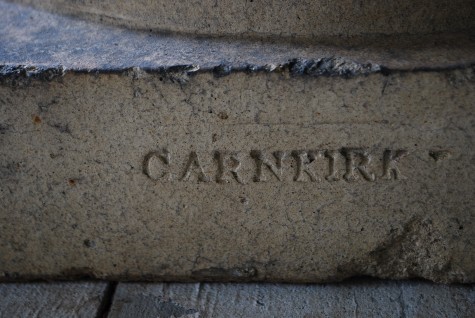 It has been three years since I have shopped for garden ornament in England. This past October, Rob travelled to England and shopped furiously over the course of 2 weeks; just 2 days ago, our first container was finally delivered. The shipping has always been an arduous experience, but this shipment was a lesson in the new world order. No dirt, unknown organisms or moss could be imported. My customs broker requested a crew to come to their warehouse-to dry brush any and all soil and moss from our antique and vintage garden items. I was reluctant to remove all of the beautiful evidence of age, but I complied. The rare Scottish Garnkirk fireclay urn circa 1860-1870 pictured above-I just wanted to have it in my possession, along with all of the other things aboard our container.
It has been three years since I have shopped for garden ornament in England. This past October, Rob travelled to England and shopped furiously over the course of 2 weeks; just 2 days ago, our first container was finally delivered. The shipping has always been an arduous experience, but this shipment was a lesson in the new world order. No dirt, unknown organisms or moss could be imported. My customs broker requested a crew to come to their warehouse-to dry brush any and all soil and moss from our antique and vintage garden items. I was reluctant to remove all of the beautiful evidence of age, but I complied. The rare Scottish Garnkirk fireclay urn circa 1860-1870 pictured above-I just wanted to have it in my possession, along with all of the other things aboard our container.
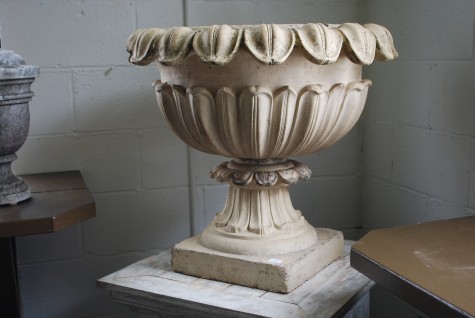
Antique garden ornaments have that history that guarantees a story. What are those stories? The Garnkirk company was founded opened for business in 1832, by Mark Sprot. He had purchased Garnkirk House in 1811; the Garnkirk Colliery and Brickfield was created nearby. The name was later changed to the Garnkirk Fireclay Company. Their fireclay, used to manufacture firebricks and firebrick products, quickly gained a reputation for very high quality and an exceptional light color. A business in brick, glazed water pipes and other architectural items expanded into beautiful objects for the garden. By 1833, it became apparent that the ornamental products they made for gardens were a growing and important part of the company. Garnkirk garden ornament was said to “exhibit pleasing forms and a soft mellow shade of color, harmonizing admirably the hue of foliage and turf”. This reference comes from the Horticulturist, in an article published in July of 1848. My source for this? A Sotheby’s auction catalogue from 1999.
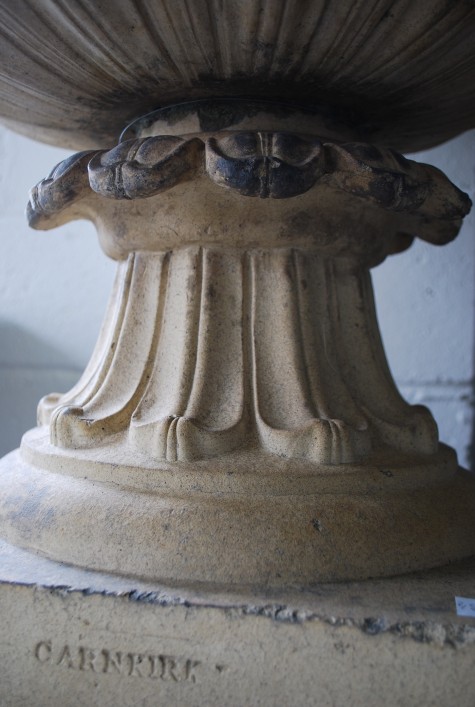 The Garnkirk Fireclay Company was the largest of its kind in Britain. The seam bed of fireclay varied in thickness from four to nineteen feet, located some 150 feet below the surface. The clay was of a composition such that objects made from it had great strength and beauty. The same could be said for the clay found in Impruneta, Italy; entire local industries developed from the availability of beautiful and strong clay. Garnkirk products were shipped all over the world, including the US.
The Garnkirk Fireclay Company was the largest of its kind in Britain. The seam bed of fireclay varied in thickness from four to nineteen feet, located some 150 feet below the surface. The clay was of a composition such that objects made from it had great strength and beauty. The same could be said for the clay found in Impruneta, Italy; entire local industries developed from the availability of beautiful and strong clay. Garnkirk products were shipped all over the world, including the US.
 In 1869, their employees numbered close to three hundred. Some 200 tons of clay were used daily. By 1895, the fireclay pits were exhausted. The company continued production until 1901, when it closed. It is easy to see why this particular clay was so prized. It has a dense and smooth surface which reflects light beautifully. I am sure that density has much to do with the fact that these urns have relatively little damage, considering that they are 151 years old.
In 1869, their employees numbered close to three hundred. Some 200 tons of clay were used daily. By 1895, the fireclay pits were exhausted. The company continued production until 1901, when it closed. It is easy to see why this particular clay was so prized. It has a dense and smooth surface which reflects light beautifully. I am sure that density has much to do with the fact that these urns have relatively little damage, considering that they are 151 years old.
 The urns have been colonized by moss, and have patches of black typical on garden ornament from this period. The engine powering the industrial revolution in the British Isles was coal. I have seen limestone pieces completely blackened from coal smog.
The urns have been colonized by moss, and have patches of black typical on garden ornament from this period. The engine powering the industrial revolution in the British Isles was coal. I have seen limestone pieces completely blackened from coal smog.
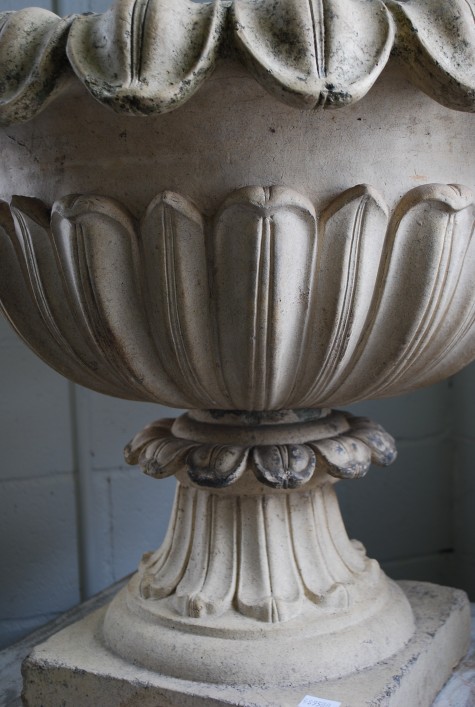 None of the research I have done on these urns has revealed who designed them. The petalled rim is quite beautiful and sculptural, and clearly derived from natural forms. The incised detail is crisp and dramatic. The proportions are handsome. Some very talented person designed these-would that I could know something about them.
None of the research I have done on these urns has revealed who designed them. The petalled rim is quite beautiful and sculptural, and clearly derived from natural forms. The incised detail is crisp and dramatic. The proportions are handsome. Some very talented person designed these-would that I could know something about them.
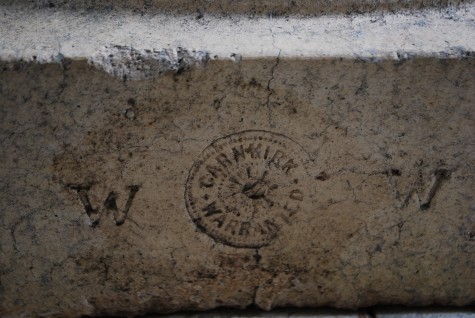
I only know where these urns were for the past year; this leaves 150 years unaccounted for. I do so wish that story could be told; I am sure it would be a tale worth listening to.
Lovely! Is there just the one?
There is a pair. You are right-they are indeed lovely.
I am currently researching my family tree and have found that several generations of my ancestors were born and lived in Garnkirk and worked in Garnkirk Fireclay Company. Thanks for publishing this. I particularly liked the photographs and I too would love to know more about their story.
Dear John, finding information is not so easy. If I run across anything else, I will email you. Good luck! Deborah
Hi Deborah, I have a pair of garnkirk urns which I love and would never part with , funny I just yesterday said to my self I was going to start a web search of the makers ,
My urns are similar to your own with the leaf design
but mine runs all the way up urn but with a larger flute ,
They are so beautiful. And so difficult to find. This is the only pair Rob has ever found.
I may have a clue as to who may have been involved in the design of Garnkirk urns. He was certainly involved in the making. My research is a work in progress. In his book ‘Garnkirk Fireclay’ George Quail says that ‘many of the workers were Irish although there was also an Italian sculptor called Luigi’. The Luigi that he refers to is Luigi Isepponi my great great great grandfather who arrived in Scotland circa 1829. He exhibited his terracotta sculpture at Edinburgh Royal Scottish Academy over 5 years from 1830. He also exhibited in Glasgow during this period. The 1851 census confirms Luigi’s residence in the parish of Cadder of which Garnkirk was a part.
Dear Helen, thanks for this. Do write again if you learn more. Deborah
Hi, Deborah,
Just a little bit more information on Luigi Isepponi, who is my great-great grandfather. He lived in the parish of Cadder, as Helen Petrie said, in 1851 in which year he married a local girl, Mary McLachlan. By 1863 he was apparently living in Dunfermline. In the various documents I have found Luigi is listed as a sculptor, a modeller and a modeller (fine clay). In the 1830s he not only displayed vases of Garnkirk terracotta at the Royal Scottish Academy in Edinburgh, but also a bust of Mark Sprot and one of “Master G. Sprot and North Pole Dog”, also in Garnkirk Terracotta. He seems to have had an association with Garnkirk and the Fireclay Company over a period of almost 30 years. I would imagine he had something to do with design, but that we shall probably never know.
If you could forward my e-mail address to Helen Petrie I would be grateful, but if not that’s OK.
I came across your web page by accident, thanks to Helen’s reference to Luigi! Very interesting.
Hello, just doing some family research and discovered the info about Luigi Isepponi. My wife is related – her mother is a Lamont, her mother being Betty Lamont whose brother was Derry.
It’d be interesting to see where all this leads us. BTW we live in Kinghorn now
best wishes
John
Hello,
I am THRILLED to find this blog today as I am researching my McQuillan Irish ancestors who are said to have worked at the Gartkirk Colliery ans Fireclay Works!!
This was a fascinating insight for me onto what they actually did in that industry!!
If you have found any further detail I would e most interested!
Regards
Sheryl
two chimney pots possibly made or designed by Mr Isepponi were seen near Aberdeen,Scotland. Very similar design. They are stamped W GARNKIRK WARRANTED W
Dear Ian, thank you for your letter. best regards, Deborah
Hi Deborah, If you look here https://www.scottishbrickhistory.co.uk/luigi-isepponi-sculptor/
there are pictures of my chimney pots.
Regards, Ian.
Dear Ian, I did take the liberty of reading your article earlier this afternoon. I told my business partner and buyer Rob how pleased I was that a post of mine from 2011 was still a topic of conversation, and warranted a footnote in your article. Thank you. Those urns (it is one urn now, as I have sold one) have a history that I am so keen to understand. Though I may never know the story, I still know it is an incredibly beautifully designed and made urn. Garden ornament endowed with the aura of history and art is a love of mine. I do not know the significance of the pair of W’s. But there must be a story there, as your chimney pots have the same markings. After I read your article, I went out to look that urn over in great detail. It was a visit prompted by you. I much appreciate your letter. best regards, Deborah
Evening Deborah. I will keep you informed of developments and i’m glad you get so much enjoyment from these products. I must say though that the Scottish Brick History website is not my project, i’m only a humble contributor to it and brick collector in my own right. I have a Facebook page called Scottish Brickmarks but nothing more scholarly. All the best, Ian.
Hi
My Grandfather was a Clay miner next to this Works at Gartcosh.
Garnkirk made the first water pipes and sewer pipes in general use in Scotland.
You can find the image of the Factory and the sales and product price lists.
The poor Irish did indeed work here.